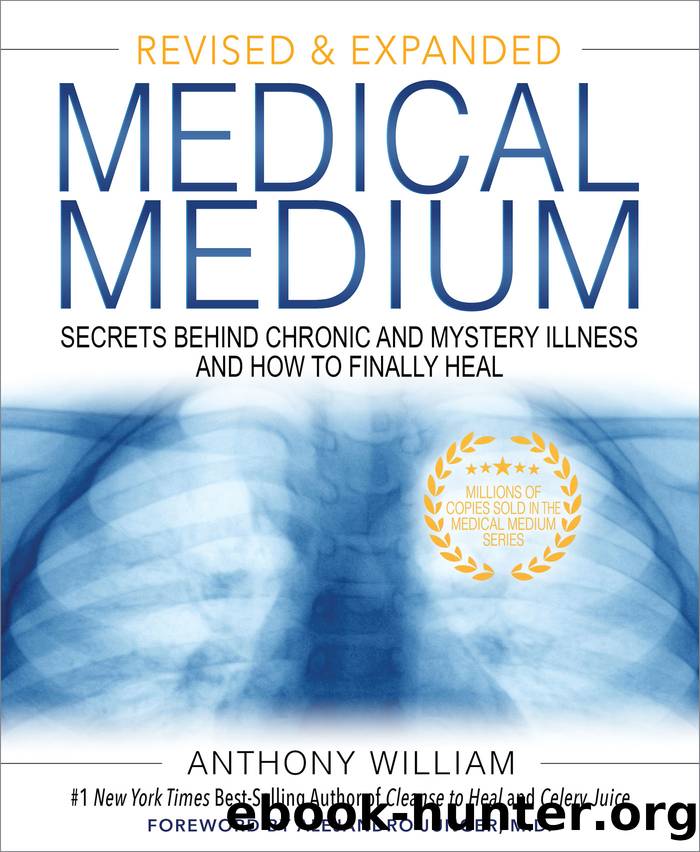Medical Medium (Revised and Expanded Edition) by Anthony William

Author:Anthony William [Anthony William]
Language: eng
Format: epub
Publisher: Hay House
Published: 2021-01-19T00:00:00+00:00
THE TRUTH ABOUT HORMONE REPLACEMENT THERAPY
Pharmaceutical companies actively encouraged the hormone trend when they realized billions could be made by demonizing menopause and creating drugs to âcureâ it. In the early 1960s a major promotional campaign was launched claiming that âestrogen deficienciesâ were the cause of most of the ills being felt by women before, during, and after menopause. Sales of products promising to replace the supposedly missing estrogen âcalled hormone replacement therapy (HRT)âskyrocketed.
HRT had actually been in the works for some time. When doctors started to diagnose women with hormone issues, pharmaceutical companies suddenly had a use for their steroid-based lab experiment. They sent patients the message, âWe see your pain, so we developed this revolutionary treatment for you.â In reality, they were just picking this as the perfect moment to release the products that had already been in development and hadnât had an application until now.
HRT products hardly ever produced any positive results, though. In rare cases, HRT did minimize some symptoms. However, HRT managed this not by genuinely addressing an imbalance in the body, but by acting as a steroidâthat is, suppressing the immune systemâs response to viral inflammation, nutritional deficiencies, and exposure to toxins such as DDT.
In other words, HRT didnât make anyone healthier. On the contrary, in some cases it hid diseases by temporarily preventing the immune system from fully reacting to and combating them. So while it sometimes provided symptom relief, HRT allowed cancers, viruses, bacteria, and more to continue attacking womenâs bodies and aging them rapidly without their knowledgeâat least, until the damage became so severe it couldnât be covered up any longer.
Suddenly, doctors were noticing cancer and strokes on the rise among the women taking HRT. It was just a glimpse of the true problems hormone replacement had been causing, yet it was enough to get attention. When the news was reported, sales droppedâfor a while. Soon, another promotional campaign claimed that an adjustment to the products had addressed the problem, and HRT became popular again.
Then in 2002 an enormous clinical study called the Womenâs Health Initiative, which ran for over a decade and involved more than 160,000 postmenopausal women, caught on to more of the havoc that HRT had been wreaking and concluded that HRT substantially increased the risk of breast cancer, heart attacks, and strokes.* That is, hormone replacement therapy rapidly sped up the aging process. Once again, HRT sales plummeted.
When the findings came to light about HRTâs dangers, it should have been banned. It should have prompted researchers to look into what was really behind womenâs mystery symptomsâand started them down the path to the discovery that hormones were never the problem.
Instead, another strategy came into the mix: bioidentical hormone replacement therapy (BHRT).
BHRT is much safer than the previous drugs used in HRT. Every doctor is smart enough to know that, at this point, BHRT remains experimental. Itâs at the beginning of a 30-year journey of trial and error, just as HRT once was. At least itâs not starting from scratch.
Download
This site does not store any files on its server. We only index and link to content provided by other sites. Please contact the content providers to delete copyright contents if any and email us, we'll remove relevant links or contents immediately.
| Acupuncture & Acupressure | Aromatherapy |
| Ayurveda | Chelation |
| Chinese Medicine | Energy Healing |
| Healing | Herbal Remedies |
| Holistic | Homeopathy |
| Hypnotherapy | Massage |
| Meditation | Naturopathy |
| Reference |
Inner Engineering: A Yogi's Guide to Joy by Sadhguru(6753)
The Power of Now: A Guide to Spiritual Enlightenment by Eckhart Tolle(5681)
Fear by Osho(4699)
Ikigai by Héctor García & Francesc Miralles(4176)
The Art of Happiness by The Dalai Lama(4095)
The Ultimate Bodybuilding Cookbook by Kendall Lou Schmidt(3907)
Yoga Therapy by Mark Stephens(3722)
The Little Book of Hygge by Meik Wiking(3662)
The Healing Self by Deepak Chopra(3529)
Why Buddhism is True by Robert Wright(3424)
The Hatha Yoga Pradipika (Translated) by Svatmarama(3282)
Being Aware of Being Aware by Rupert Spira(3248)
Shift into Freedom by Loch Kelly(3168)
Wild Words from Wild Women by Stephens Autumn(3117)
Work Clean by Dan Charnas(3081)
Happiness by Matthieu Ricard(3021)
More Language of Letting Go: 366 New Daily Meditations by Melody Beattie(3004)
Yoga Body & Mind Handbook by Jasmine Tarkeshi(2850)
Why I Am Not a Feminist by Jessa Crispin(2725)
